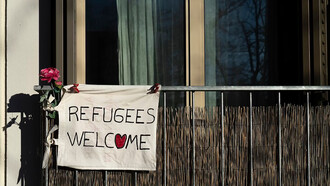The work is masterful, fiery and generous. The development absorbs exciting sites in the four corners of the kingdom. At its time, Morocco evolved under the impulse of a king builder.
Since his accession to the glorious throne, HM King Mohamed VI has drawn up an exclusive road map for the development of the country. In all respects, the Sovereign gives the example and allows the rhythm.
A multi-faceted process that constantly widens its path, in various sectors, including at its head: the major projects of modernization of infrastructures which constitute the backbone of any country.
Morocco in the 21st century has developed really fast, and continued to achieve success after another, thanks to an insightful royal orientation tending to concretize a voluntarism approach concerned with equipping itself with installations, logistic platforms and excellent infrastructures.
Morocco launches the First TGV in Africa and one of the world biggest ports
The TGV is thus another valuable addition to many other structuring projects, Al Boraq, Lines of 200 km, a speed of 320 km/h and financed with nearly 23 billion DH, the first TGV in Africa and in the Arab world rolls in Morocco, and connects two major economic centers: Tangier and Casablanca.
An inauguration in great pomp was accompanied by the launch of major railway projects, the tripling of the Casablanca - Kenitra axis, the complete doubling of the Casablanca - Marrakech line, the opening of the stations dedicated to High Speed Trains: Rabat-Agdal, Tangiers, Kenitra and Casa-Voyageurs, and new stations of Oujda and Benguerir.
On its own, the success of the Tangier Med port illustrates this sustained momentum of development because of its global capacity of 9 million containers, an industrial platform of 5000 hectares, and a recent extension by the opening of Tangier Med 2. Another dream that came true after twenty years, the mega infrastructure is the first in Africa and the first in the Mediterranean in terms of capacity.
The kingdom enters the closed club of the big port countries. The complex boasts three ports and sea connections with 186 ports in 77 countries around the globe.
Morocco automotive and aeronautics industries attracts investors
And on this logistics platform, import export activities are intensifying mainly in the automotive sector, which makes Morocco a big hub in Africa. After the Renault plant in Tangiers, and that of PSA in Kenitra, the country welcomes the Chinese BYD, electric vehicle specialist.
Many factories are built or are under construction in several regions. Six of these plants are expected to equip cars with the diamond brand, while thirteen others should equip the PSA vehicles.
An industry that breaks records in the continent, in less than 10 years, the country climbs on the podium of the car manufacturers top countries.
Aeronautics is the other strong link in the global professions of the kingdom.
Just like the automobile, it carburets with the export, in 2018, the aeronautics takes more altitude. Exports increased by 15% to more than 1.87 billion. The boom of this sector is appealing to the aerospace giants, the American builder Boeing and the Canadian Bombardier, which, through a partnership with Morocco, are contributing to the creation of an ecosystem aiming at generating new technologies and expanding sources of annual export earnings through welcoming new suppliers and creating new skilled jobs.
Mobility as a priority!
The road and motorway network is not left out in this dynamic increased development. Morocco is working on the extension of the motorway network and expressways in accordance with the standards established internationally.
The network of Moroccan motorways continues to grow about 1900 kilometers long, and it is one of the densest networks in Africa. 70% of the country's major cities are connected by motorways. And by 2035, a new highway plan aims to open up the most remote regions and integrates them into the development process.
The other battleground for the modernization of infrastructures, airport platforms, just as strategic as the others, as a vast plan for the development of airport infrastructures is taking off.
In January 2019, His Majesty the King inaugurates the project of extension, re-development and modernization of Terminal 1 of Mohammed V International Airport in Casablanca: a major platform for airport correspondence and a hub in the region and in Africa, with 14 million of passengers each year.
In addition to all of the above mentioned came the commissioning of the Regional Control Center for the safety of air navigation in Agadir, as well as the new air stations in Guelmim, Zagora and Errachidia Moulay Ali Cherif airports. Other airport infrastructures come out of the ground, establishing new terminals of the airports in Marrakech Menara, Fez Saiss and Rabat Salé.
Projects that change the image of an entire country, the prowess in terms of infrastructure are linked together and are not alike, accessibility and originality qualify from the outset buildings like no other: cable-stayed bridges, architectural jewels that allow the traffic between urban centers of a great demographic density to be very fluid, the first bridge of that kind is that of Rabat named after the sovereign, it is also a first in the whole continent. 900 meters long, this suspension bridge is part of the highway bypass of the capital and is by its architecture one of the most beautiful books in the country, close to the Bouregreg valley.
Other projects on the rails, the extension of the lines of Casablanca and Rabat Sale trams, to support the demographic and urban development of these major cities, an additional 25 kilometers for the salted flats axis, and new lines in the economic capital on the horizon 2022.
Morocco Pioneer renewable energy projects
An ecological means of transport perfectly suited to the challenges of the kingdom's sustainable development. The country is aiming at the rising of projected renewable energy targets, which are set to exceed the current target of 52% of the national electricity mix by 2030.
The Moroccan Solar Plan has been a great success through the exploitation of the entire Noor solar complex of Ouarzazate, the largest in the world that is ever built; the solar power consecrates its position alongside other power stations: Noor Laayoune I and Noor Boujdour I.
Morocco is embarking on the race for innovation by developing new sources: wind, geothermal and solar ones. For its energy transition, the country has implemented 55 projects through investments that reached 55 billion dirhams.
The country stands today as a pioneer model in its regional and continental space and always dreams big, it has entered the club of the nations which put space at the service of its development. Projects, performances, and future ambitions of the most creative energies: it is the resolute and determined march of a nation under the royal leadership that puts man at the heart of every work.















